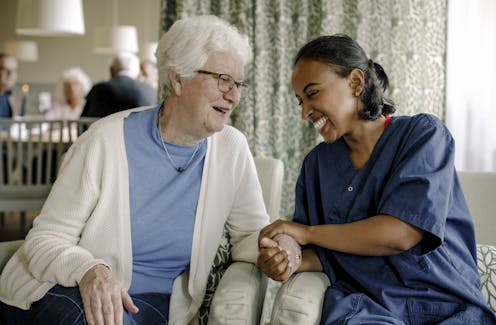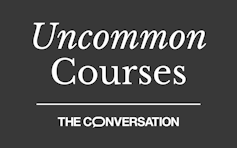

Uncommon Courses is an occasional series from The Conversation U.S. highlighting unconventional approaches to teaching.
Title of course
“Legacy Building with Older Adults – Students Re-Humanizing Health Care”
What prompted the idea for the course?
In March 2020 – as the COVID-19 pandemic was causing widespread lockdowns across the U.S. – I heard from a chaplain friend about older adults who were dying in assisted living facilities and skilled nursing homes indirectly because of social isolation and loneliness.
I was finishing my dissertation, focused on developing a curriculum to assist underrepresented and underserved university students. But after hearing about the needs of older adults, I was moved to do something to help them.
So I shifted my focus and geared my curriculum toward bridging the needs of older adults, who are also often underserved, with young people who are learning the principles of health care.
I developed the concept and then piloted it at my alma mater, the University of Toledo, with counseling and pre-med students. I then further developed it to be suitable for a course aimed at connecting university students in health-care-related fields with older adults who may feel isolated and alone.
What does the course explore?
This course covers issues in social and cultural determinants of health. Social determinants of health are the conditions in the environments where people live, play, work, attend community events – and where they age. These environments can influence what decisions people make, and the decisions they make can affect a wide range of health and quality-of-life results.
Students in this course connect with older adults once a week, for one hour, in person, via phone or through virtual visits. Throughout the course, students receive training materials in growth mindset, resiliency, mindfulness and goal-setting both for themselves and for the older adults. Students are also trained in reminiscence therapy, which is an approach to help students guide or support the older adult, reaffirming the value of the adults’ stories as they reminisce.
The sessions that involve discussions between students and older adults focus on building rapport and connecting. They also allow for an older adult to impart wisdom and share stories of their past with the students. At the end of the sessions, the older adult participants receive a digital or physical book – which I call a legacy book – that summarizes the stories the older adult shared with the student, to help reinforce that their story matters.
Why is this course relevant now?
One of the most profound lessons from the pandemic has been that staying connected is important for one’s health.
Emerging research shows how social isolation and loneliness before and during the COVID-19 pandemic are correlated with many physical and mental health problems, including heart disease, diabetes, high blood pressure, heart failure, stroke, dementia, anxiety, depression and suicide.
Researchers estimate that health issues caused by isolation and loneliness increase the risk of early death by 26% and have been equated to smoking 15 cigarettes a day. One of the major ways to build a foundation for addressing isolation and loneliness is building connection between generations.
Many older adults said the most valuable part of the program for them was the relationship and friendship they developed with their legacy builder. One older adult reported back that it was uplifting to know that she could communicate well with the younger generation, and that she is now more confident in talking with her young adult grandchildren.
Older adults can also learn new technology skills from their legacy builder. Many have started texting for the first time and learned how to send pictures via text. Another learned from her legacy builder to create a Facebook account for herself, and she now stays connected with the student through Facebook.
What’s a critical lesson from the course?
The critical lesson that I hope students take away from the course is that every person has value, and it is worthwhile to listen to the person’s stories to understand what they value and why it matters so much.
I want students to learn how they can reinforce the strengths and self-efficacy in another individual by valuing their stories and lived experiences. I also want health care students in particular to understand that those they serve are the experts of their own lived experiences and have a story worth listening to. On top of that, each person has something to be learned from the other. Ultimately, both leave the conversation feeling edified and uplifted.
What materials does the course feature?
The content mainly focuses on communication and listening skills, with mindfulness, growth mindset and goal-setting strategies. Emphasis is placed on gaining skills in interviewing, connection and building rapport.
What will the course prepare students to do?
The course will prepare students to treat the people they serve and care for as human beings, whether or not the student enters the health care field.
We all are children of someone. We all have birthdays. I believe we all deserve to live a life with a sense of dignity, respect and honor. We all need connection, and, whether it be in health care or everyday life, this is a skill that must not be left out of the curriculum.
Jeremy Holloway owns a program called Tellegacy that supports student connections with older adults outside of the North and South Dakota area. He receives support through the Department of Geriatrics in the University of North Dakota to provide service and a course for students and older adults in North and South Dakota.
This article was originally published on The Conversation. Read the original article.







